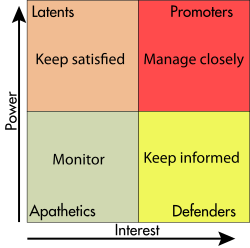Dealing with Difficult Stakeholders during the Agile Transition
Agile transformation is no simple feat because it requires change, and change is scary on many levels for most of us. Changing the way we think about and execute work is one of the most difficult things we might face as professionals, especially I we have been doing things one particular way for years, maybe even decades, and have achieved a certain level of success. There is plenty of data that suggests sponsorship is one of the most important factors when it comes to process improvement initiatives, and this is common sense. However, knowing that we need sponsorship and acquiring and sustaining it over the long haul are two completely different concerns.
As knowledge workers, managing expectations is nothing new, right? We all understand the importance of “managing up”; if you are like me, I have a feeling that most of the time, you spend most of your work day doing whatever you can to help our boss look good. I am fairly confident that you have figured out how to do so successfully. However, when it comes to adopting Agile practices, it requires more than just making your boss look good, you will need to expand your horizon and your sphere of influence in order to be successful. You will likely want to consider the following:
- Identify all of your Agile stakeholders. The Interest and Influence matrix (also known as the “Stakeholder Analysis Matrix”) that is commonly used for traditional project management still works well here; you need to carefully and strategically determine who have “a skin in the game”, who has influence to assist you in this initiative. Assembling this matrix will help you achieve these goals.
- Focus your energy on “key” Agile stakeholders. If you build the matrix I recommended above, you will likely come up with a big list of names. Focus your attention on the ones that highest level of “interest” as well as “influence” – those are the people who have the most to gain (or lose) from your project. It is critical that you allocate time to establish a solid relationship with these individuals who will have the power and authority to help you.
- Middle management is where “the battle is won or lost”. In my experience, it is usually relatively easy to convince senior leadership or individual contributors to at least experiment with Agile methods. However, middle management is where many Agile transformation initiatives flourish or flounder. I will share my thoughts on the reasons shortly, but this is where you will likely want to invest your time.

Once you understand who your Agile stakeholders are, you should be in a much better position to strategically plan out your transformation initiative. So why is middle management key to this entire effort? Here are a few reasons:
- Middle managers are impacted the most. The responsibilities of a functional manager will likely be the most impacted by the adoption of Agile practices because most of the time, these are the individuals with the most to lose; their level of authority will likely be diminished by the implementation of self-organizing, autonomous teams. These managers may no longer be able to delegate or set priorities as they have done previously, which can create fear and resistance, either active or passive.
- Middle managers don’t understand how they fit into the new Agile paradigm. Within the new Agile/Scrum team structure that you are likely going to impose, there is often confusion as to how the functional managers will fit in; are they expected to serve in the Scrum Master role, or perhaps even the Product Owner? Neither may sound very attractive to the middle manager who has worked hard to get to this position, and changing to an entirely new role may not be aligned to his/her career objective, which is likely to continue climbing the corporate ladder to a more senior management position.
- Middle managers see no benefit in changing or supporting this initiative. Similar to losing authority, many middle managers struggle to figure out the WIIFM (What Is In It For Me)? If the company is completely overhauling the organizational structure and the way that work is managed and executed, this may create a big career risk with no benefits.
How should you address all of these dynamics that may arise? There is no simple answers here because every organization is different, and depending on the context, you could deploy a different solution. The bottom line is that keen awareness of your stakeholders is the starting point to any successful Agile transition. You need to do your due diligence to uncover the people who will support you, as well as finding ways to help others adapt to the new world, potentially by taking on different roles that they may not have even imagined. Convince them that this is their opportunity to pivot and do something unexpectedly different that may actually help them propel to newer heights of job satisfaction. Yes, I know…easier said than done…so take it one step at a time!




